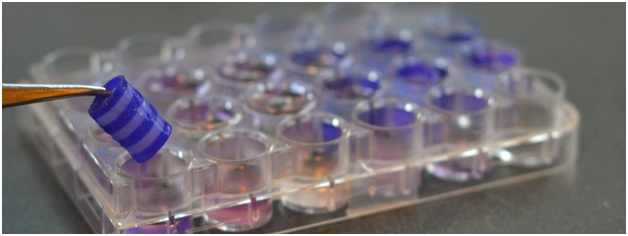Bio-printing tissues for cheaper, faster drug testing
March 28, 2014

A 3D-printed tube dyed for clarity. This is a simple demonstration that was printed with a single printer nozzle being fed by two different materials. The microfluidic print head sequenced the two materials into the banded structure. (Credit: Aspect Biosystems)
Bio-printed tissues can help better predict and test whether a drug will be effective on people and at less cost, researchers at the University of British Columbia Department of Electrical and Computer Engineering and spinoff Aspect Biosystems hope to prove.
Ultimately, this work could also lead to growing organs for human transplant.
Developing a new drug costs upward of $4 billion, a fee that gets passed on to patients, according to the researchers. Even after extensive testing in the lab and on animals, only a handful of drugs are successful enough to go to clinical trial in humans. Astonishingly, the failure rate of drugs in clinical trials is 90 per cent because humans and animals often respond differently. This expensive process can take over a decade.
“There are 200 ways to cure pulmonary fibrosis in mice but not a single cure for the disease in humans,” says Sam Wadsworth, co-founder and director of biology of Aspect Biosystems. He and his colleagues have discovered a technique for growing 3D human airway tissues that almost exactly replicate the lung wall. Compared to the standard technique of growing sheets of cells in a dish or test tube, this is a major improvement, he says.
“We use our airway cultures to model a disease where the animal models have been poor predictors for drug discovery,” says Wadsworth, who is also a research associate at the Institute for Heart and Lung Health at St. Paul’s Hospital, where he works on the BRONCH project. “Pulmonary fibrosis is a rare but terrible disease. If you don’t get a transplant, you’ll die.”
A new 3D printer design for tissues, using a microfluidic chip
“Our 3D bioprinting technology uses the layer-by-layer fabrication approach seen in existing 3D printing systems; however, the material we are printing is composed of living human cells, extracellular matrix material, and other factors,” Simon Beyer, Aspect Biosystems Co-founder & Director of Hardware, explained to KurzweilAI in an email interview.
“We have incorporated microfluidic technology into the print head such that we are able to manipulate the printed materials in very unique ways, including the sequencing of different cell types, and the ability to generate complex arrangements of the materials prior to deposition. That is, the composition of our base printing unit (a fiber) is not restricted to just one material, but can have a programmed composition including many different materials (in this case the different materials are different types of human cells).
“This way we are able to capture intricate physiological geometries that are composed of many different types of cells. Once printed, the tissue constructs are incubated for several days, or longer, to allow the cells to form a tissue network.
“In the near term, we are creating relatively simple 3D human tissue constructs to be used by pharmaceutical companies in pre-clinical drug testing. Conventional drug development and testing methods rely on the use of 2D cell cultures and animal models. Unfortunately, 2D cultures cannot model the complex 3D intercellular interactions occurring in our organs, and animals are poor predictors of the human drug response.
“Thus approximately 70% of investigational new drugs fail to show efficacy in human trials. These “false starts” contribute significantly to the high costs associated with drug development. The more physiologically relevant human tissues models we provide will improve the predictive accuracy of the pre-clinical drug development process and reduce the cost of clinical trials. In the future, more complex tissue models could be used for applications such as wound and tissue repair, implantable grafts, and eventually whole organ replacement.”
“In comparison to other 3D bioprinting systems, the few that are out there, we have taken a very unique approach. Rather than reuse existing 3D printing technology and modify it to print biological materials, we have designed a 3D printing technology from the ground up, specifically tailored to printing biological materials. Our printer can rapidly construct a macro-scale tissue, but contains microfluidic technology within the print head that can manipulate the materials on the micro-scale and capture the intricate details seen in real human physiology.
“We are currently working with customers on a one-on-one basis and expect to have products online over the next two to three years. We currently do not have plans to release the printing technology itself as a product, but will rather be providing printed tissue structures in a multi-well plate format.”